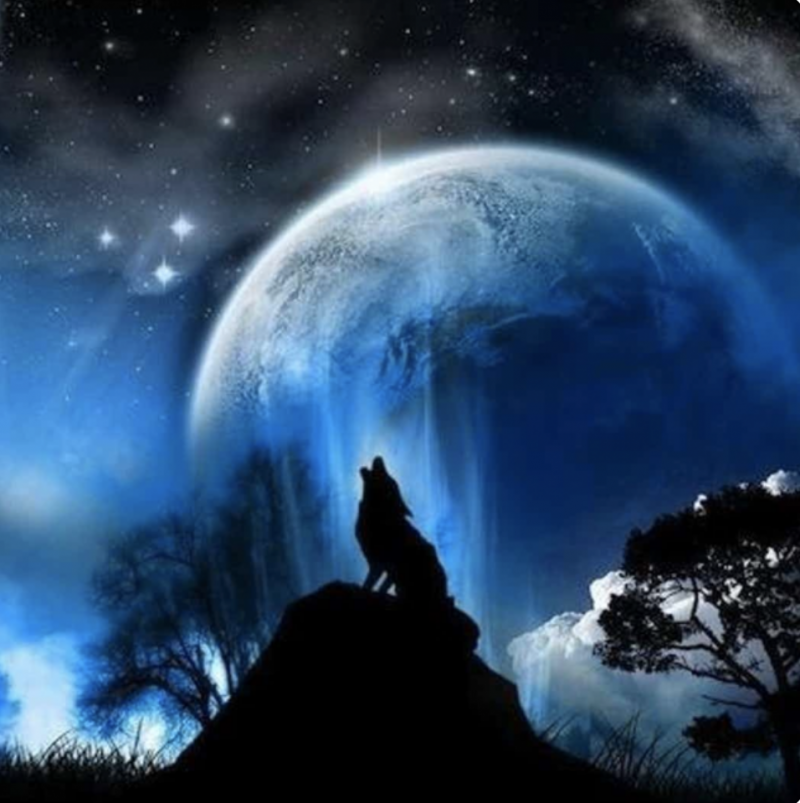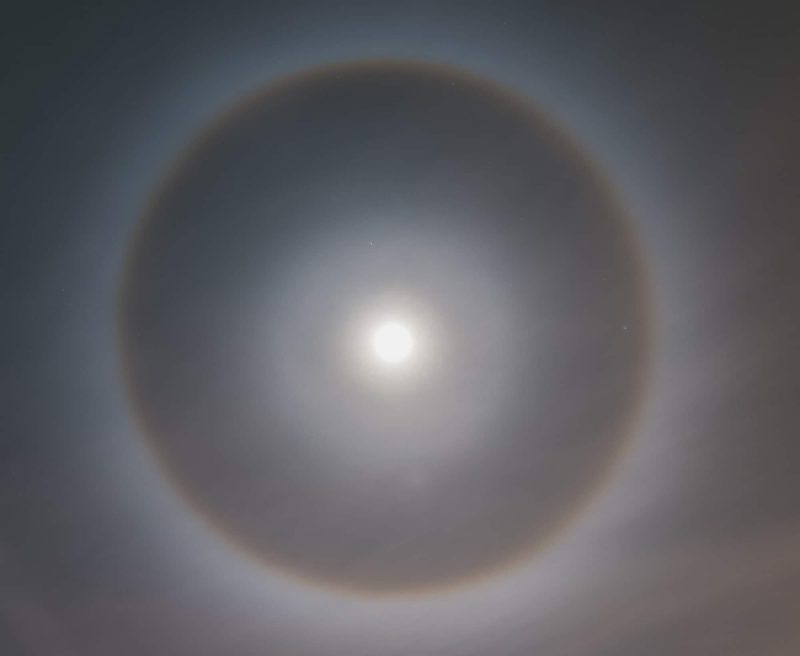
Our last full moon was on December 19, 2021, which was two days before the Northern Hemisphere’s December solstice. This means January’s full moon is the first of the Northern Hemisphere winter season (Southern Hemisphere summer season). And, for all of us, it’s the first full moon of 2022. Those of us in North America often call this full moon the Wolf Moon, Snow Moon or Hunger Moon.
We generally say the moon is full for a few days around the crest of the moon’s full phase. Around the world for the next few nights – January 16, 17, and 18, 2022 – a full-looking moon lights the nighttime from dusk until dawn. But, to astronomers, the moon is full at a well-defined instant: when it is directly opposite the sun (180 degrees from the sun in ecliptic longitude). That full-moon-moment will arrive on January 17, 2022, at 23:48 UTC. In North American and U.S. time zones, that translates to: January 17, at 7:48 p.m. Atlantic Standard Time (AST), 6:48 p.m. Eastern Standard Time (EST), 5:48 p.m. Central Standard Time (CST), 4:48 p.m. Mountain Standard Time (MST), 3:48 a.m. Pacific Standard Time (PST), 2:48 a.m. Alaska Standard Time (AKST) and 1:48 a.m. Hawaiian Standard Time (HST).

Where does the name Wolf Moon come from?
It’s tempting to think of hungry wolves howling outside snow-covered villages at this time of the year. The name is often said to come from Native American culture, but Indian Country Today pointed out in 2013 that the name Wolf Moon doesn’t appear on the lists of American Indian moon names compiled by Phil Konstantin, who worked for NASA, among other places. Indian Country Today wrote:
Of the 29 tribes listed [by Phil Konstantin], not one actually calls January the Wolf Moon, although the Sioux name is Wolves Run Together Moon. The Algonquin … call the January moon squochee kesos, or Sun Has Not Strength to Thaw …
The moon names tend to mirror latitude somewhat. For instance, to the Haida in Alaska it’s táan kungáay, or Bear-Hunting Moon. The Hopi in southwest Arizona call it paamuya, Moon of Life at its Height. In the Pacific Northwest it’s atalka, meaning Stay Inside. Moving farther south, the Choctaw word for the January full moon is rv’fo cusee, which means Winter’s Little Brother (as opposed to December’s moon, rvfo-rakko, meaning Big Winter).
Watch the full moon’s path
If you’re an observer of seasonal changes in the night sky, you might know the Hopi name for this moon – paamuya or Moon of Life at its Height. This name makes us wonder if the Hopi were comparing the January full moon to the summer sun. It’s a good name because (no matter where you are in the world), the January full moon does indeed take the position and follow the path of the sun six months from now.
For us in the Northern Hemisphere – where the sun is continuing its low arc across the daytime sky (albeit getting higher by the day) – the January full moon rides high in the sky. This makes it appear to mimic the path of a summer sun. If you’re in the north, watch for the high January full moon especially around midnight (midway between your local sunset and sunrise). It’ll be like a noontime summer sun. North of the Arctic Circle, this full moon stays out around the clock, like the midnight sun of summer.
Meanwhile, in the Southern Hemisphere – where it’s now summer – this full moon follows the low path of a winter sun. At midnight, the moon sits low in the northern sky, just like the noonday winter sun. South of the Antarctic Circle, the January full moon remains below the horizon for 24 hours around the clock.
Constellations and the full moon
Thinking of it in terms of constellations, the late January sun beams in front of the constellation Capricornus. The late January full moon moon shines in front of the constellation Cancer. Six months from now, in early summer, the sun will shine in front of that constellation.
Now think of the moon not in terms of its grand seasonal trek in front of the fixed star background, but just in terms of what you’ll see these next few nights. All full moons are, more or less, opposite the sun. So you can expect to see a full-looking moon in the east at dusk and early evening tonight and tomorrow. It’ll climb upward in the evening hours, and soar to its highest point at or around midnight. If you’re an earlier riser, watch for the moon these next couple of mornings, low in your western sky during the wee hours before sunrise.

Bottom line: Enjoy the full-looking moon for a night or two on either side of January 17, 2022, when it brings the northerly latitudes some good cheer on this long winter night.
The post January’s full moon: Wolf Moon and 1st full moon of 2022 first appeared on EarthSky.
from EarthSky https://ift.tt/3rp8LGI

Our last full moon was on December 19, 2021, which was two days before the Northern Hemisphere’s December solstice. This means January’s full moon is the first of the Northern Hemisphere winter season (Southern Hemisphere summer season). And, for all of us, it’s the first full moon of 2022. Those of us in North America often call this full moon the Wolf Moon, Snow Moon or Hunger Moon.
We generally say the moon is full for a few days around the crest of the moon’s full phase. Around the world for the next few nights – January 16, 17, and 18, 2022 – a full-looking moon lights the nighttime from dusk until dawn. But, to astronomers, the moon is full at a well-defined instant: when it is directly opposite the sun (180 degrees from the sun in ecliptic longitude). That full-moon-moment will arrive on January 17, 2022, at 23:48 UTC. In North American and U.S. time zones, that translates to: January 17, at 7:48 p.m. Atlantic Standard Time (AST), 6:48 p.m. Eastern Standard Time (EST), 5:48 p.m. Central Standard Time (CST), 4:48 p.m. Mountain Standard Time (MST), 3:48 a.m. Pacific Standard Time (PST), 2:48 a.m. Alaska Standard Time (AKST) and 1:48 a.m. Hawaiian Standard Time (HST).

Where does the name Wolf Moon come from?
It’s tempting to think of hungry wolves howling outside snow-covered villages at this time of the year. The name is often said to come from Native American culture, but Indian Country Today pointed out in 2013 that the name Wolf Moon doesn’t appear on the lists of American Indian moon names compiled by Phil Konstantin, who worked for NASA, among other places. Indian Country Today wrote:
Of the 29 tribes listed [by Phil Konstantin], not one actually calls January the Wolf Moon, although the Sioux name is Wolves Run Together Moon. The Algonquin … call the January moon squochee kesos, or Sun Has Not Strength to Thaw …
The moon names tend to mirror latitude somewhat. For instance, to the Haida in Alaska it’s táan kungáay, or Bear-Hunting Moon. The Hopi in southwest Arizona call it paamuya, Moon of Life at its Height. In the Pacific Northwest it’s atalka, meaning Stay Inside. Moving farther south, the Choctaw word for the January full moon is rv’fo cusee, which means Winter’s Little Brother (as opposed to December’s moon, rvfo-rakko, meaning Big Winter).
Watch the full moon’s path
If you’re an observer of seasonal changes in the night sky, you might know the Hopi name for this moon – paamuya or Moon of Life at its Height. This name makes us wonder if the Hopi were comparing the January full moon to the summer sun. It’s a good name because (no matter where you are in the world), the January full moon does indeed take the position and follow the path of the sun six months from now.
For us in the Northern Hemisphere – where the sun is continuing its low arc across the daytime sky (albeit getting higher by the day) – the January full moon rides high in the sky. This makes it appear to mimic the path of a summer sun. If you’re in the north, watch for the high January full moon especially around midnight (midway between your local sunset and sunrise). It’ll be like a noontime summer sun. North of the Arctic Circle, this full moon stays out around the clock, like the midnight sun of summer.
Meanwhile, in the Southern Hemisphere – where it’s now summer – this full moon follows the low path of a winter sun. At midnight, the moon sits low in the northern sky, just like the noonday winter sun. South of the Antarctic Circle, the January full moon remains below the horizon for 24 hours around the clock.
Constellations and the full moon
Thinking of it in terms of constellations, the late January sun beams in front of the constellation Capricornus. The late January full moon moon shines in front of the constellation Cancer. Six months from now, in early summer, the sun will shine in front of that constellation.
Now think of the moon not in terms of its grand seasonal trek in front of the fixed star background, but just in terms of what you’ll see these next few nights. All full moons are, more or less, opposite the sun. So you can expect to see a full-looking moon in the east at dusk and early evening tonight and tomorrow. It’ll climb upward in the evening hours, and soar to its highest point at or around midnight. If you’re an earlier riser, watch for the moon these next couple of mornings, low in your western sky during the wee hours before sunrise.

Bottom line: Enjoy the full-looking moon for a night or two on either side of January 17, 2022, when it brings the northerly latitudes some good cheer on this long winter night.
The post January’s full moon: Wolf Moon and 1st full moon of 2022 first appeared on EarthSky.
from EarthSky https://ift.tt/3rp8LGI

Aucun commentaire:
Enregistrer un commentaire